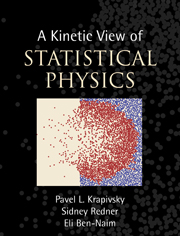9 - Coarsening
Published online by Cambridge University Press: 05 March 2013
Summary
In the previous chapter, we discussed the phase-separation kinetics or domain coarsening in the kinetic Ising model after a temperature quench from a homogeneous high-temperature phase to a two-phase low-temperature regime. Because of the complexity of the ensuing coarsening process, considerable effort has been devoted to developing continuum, and analytically more tractable, theories of coarsening. While a direct connection to individual spins is lost in such a continuum formulation, the continuum approach provides many new insights that are hard to obtain by a description at the level of individual spins.
Models
We tacitly assume that the order parameter is a scalar unless stated otherwise. We generally have in mind magnetic systems and will use the terminology of such systems; this usage reflects tradition rather than the dominant application of coarsening. There is a crucial distinction between non-conservative and conservative dynamics, and we begin by describing generic models for these two dynamics.
Non- conservative dynamics
The basic ingredients that underlie non-conservative dynamics are the following.
• The primary variable is a continuous coarse-grained order parameter m(x, t) ≡ l−dΣσ, the average magnetization in a block of linear dimension l that is centered at x, rather than a binary Ising variable σ = ±1. Here l should be much greater than the lattice spacing a and much smaller than the system size to give a smoothly varying coarse-grained magnetization on a scale greater than l. This coarse graining applies over a time range where the typical domain size is large compared to the lattice spacing.
[…]
- Type
- Chapter
- Information
- A Kinetic View of Statistical Physics , pp. 277 - 321Publisher: Cambridge University PressPrint publication year: 2010



